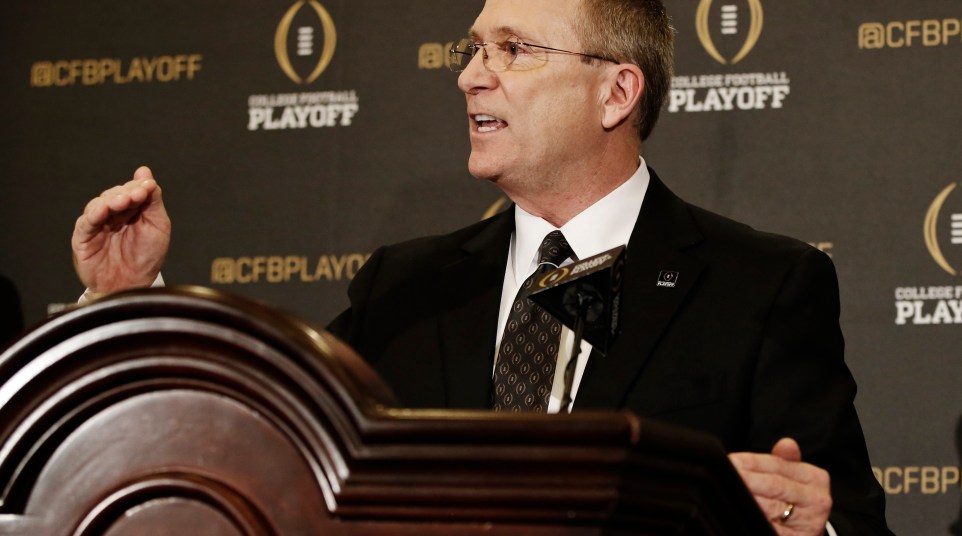Comparing the CFP Top 25 to most recent AP rankings, BCS simulation
The College Football Playoff selection committee released its newest Top 25 rankings Tuesday night on ESPN, and there was plenty of shakeup from last week’s inaugural rankings.
Oregon moved into the fourth and final potential playoff spot following Ole Miss’ heartbreaking loss to Auburn last weekend. The Ducks sit just ahead of one-loss contenders Alabama, TCU, Kansas State, Michigan State, Arizona State and Notre Dame. The two-loss Rebels remain ahead of a handful of one-loss teams from the power conferences in this week’s poll, including Baylor, Nebraska and Ohio State.
The CFP poll is now two weeks old, and we’re still learning how the selection committee thinks and what goes into their weekly rankings. A great way to assess the rankings is to compare them to more the more established rankings we’ve come to know over the years.
Below is a comparison of the top 16 teams in Tuesday’s CFP poll with the top 16 teams in this week’s AP poll and the top 16 teams from a BCS simulation done this week by BCSKnowHow.com using the old formula that once decided the national championship showdown.
| Ranking | CFP Rankings | AP Rankings | BCS Simulation |
|---|---|---|---|
| 1 | Mississippi State | Mississippi State | Missisippi State |
| 2 | Florida State | Florida State | Florida State |
| 3 | Auburn | Auburn | Auburn |
| 4 | Oregon | Alabama | Alabama |
| 5 | Alabama | Oregon | Oregon |
| 6 | TCU | TCU | TCU |
| 7 | Kansas State | Michigan State | Michigan State |
| 8 | Michigan State | Notre Dame | Kansas State |
| 9 | Arizona State | Kansas State | Notre Dame |
| 10 | Notre Dame | Baylor | Ole Miss |
| 11 | Ole Miss | Arizona State | Arizona State |
| 12 | Baylor | Ole Miss | Baylor |
| 13 | Nebraska | Ohio State | LSU |
| 14 | Ohio State | LSU | Ohio State |
| 15 | Oklahoma | Nebraska | Nebraska |
| 16 | LSU | Oklahoma | Oklahoma |
So what do we learn about the CFP from this comparison? A lot, actually.
The top 3 teams are the same in all three sets of rankings, with unbeaten Mississippi State and Florida State sitting atop the list followed by one-loss Auburn at No. 3 in all three instances.
The coveted No. 4 spot in the rankings is where it begins to get interesting.
The AP and the BCS like Alabama as the fourth and final playoff team, but the committee that actually chooses the playoff teams gave the nod to Oregon. This is not only indicative of a difference in opinion between the CFP and the AP/BCS, but of a greater trend involving the three sets of rankings.
You might notice a number of parallels atop the AP poll and the BCS simulation. That’s because the BCS formula used to be influenced by the AP and Coaches’ polls, giving voters in those polls more power than many gave credit during the BCS’ reign over college football. The AP’s top 7 teams directly match the BCS’s top 7; Nos. 8 and 9 are the same in both polls, just flipped; Nos. 10-12 are the same in both polls, just in a different order; Nos. 13 and 14 are the same, just flipped, and Nos. 15 and 16 are the exact same in both sets of rankings.
The CFP poll has the same 16 teams as the AP/BCS, but in a wildly different order, showing what little relevance the AP poll has on the selection committee’s decision-making process.
The AP poll usually weighs how many times a team lost and who that team lost to much more than how many wins a team has and who that team has beaten. Recent losses will usually hurt a team more than a recent win will help it, which is fine because A) the AP poll doesn’t decide the playoff teams and B) the AP has remained consisted in its approach since the beginning.
Because losses impact the AP poll more than wins, the AP likes a surging Alabama team with one loss on the road to a ranked Ole Miss team more than it likes Oregon and its one loss to less formidable Arizona.
The AP is also much higher on Michigan State than it is on Kansas State or Notre Dame. All three have just one loss to a top 10 team, but Michigan State lost all the way back on Sept. 6, making that loss much less impactful than Notre Dame’s loss to Florida State or Kansas State’s loss to Auburn.
There are still far too many games left to be played to have any idea what the rankings will look like on Dec. 6, but comparing this week’s CFP rankings to the AP poll and the BCS simulation show the differences in the CFP’s process to the old methods of determining a team’s worth. When you lose means little to the selection committee compared to who you lost to and who you beat. Strength of schedule and body of work matter more to the CFP than they ever did to the AP voters, and that’s going to take some getting used to.
It’s still too early to know who will reach this year’s playoff, but at least we’re beginning to understand how the selection committee thinks.

